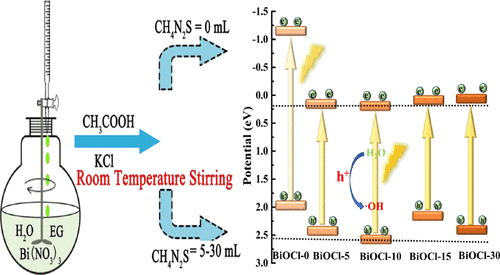当前位置:
X-MOL 学术
›
ACS Sustain. Chem. Eng.
›
论文详情
Our official English website, www.x-mol.net, welcomes your
feedback! (Note: you will need to create a separate account there.)
Narrowing the Band Gap of BiOCl for the Hydroxyl Radical Generation of Photocatalysis under Visible Light
ACS Sustainable Chemistry & Engineering ( IF 7.1 ) Pub Date : 2019-09-10 , DOI: 10.1021/acssuschemeng.9b03885 Jianhua Hou 1, 2 , Dian Dai 1 , Rui Wei 1 , Xiaoge Wu 1 , Xiaozhi Wang 1, 2 , Muhammad Tahir 3 , Ji-Jun Zou 3
ACS Sustainable Chemistry & Engineering ( IF 7.1 ) Pub Date : 2019-09-10 , DOI: 10.1021/acssuschemeng.9b03885 Jianhua Hou 1, 2 , Dian Dai 1 , Rui Wei 1 , Xiaoge Wu 1 , Xiaozhi Wang 1, 2 , Muhammad Tahir 3 , Ji-Jun Zou 3
Affiliation

|
It remains an exciting challenge to achieve a direct production of large quantities of •OH, generated from photogenerated h+ using visible-light-driven photocatalysts fabricated by a one-step method. In this work, a series of hierarchical interconnected BiOCl materials with a tunable absorption range for visible light have been successfully prepared through a one-pot molecular self-assembly technology at room temperature. Depending on the modification of polar organic molecules [i.e., thiourea (TU)], the nonpolar layered semiconductor (BiOCl) turned into an efficient visible-light photocatalyst because it possesses a narrower band gap by surface modification introducing oxygen defects. Meanwhile, the tunable three-dimensional hierarchical architecture of BiOCl was fabricated via the self-assembly of two-dimensional nanosheets with the aid of TU, leading to an enhanced specific surface area along with efficient electron–hole pair separation. Moreover, the obtained BiOCl-10 showed a more positive valence band with an optimized hierarchical porous structure, which produced a sufficient amount of •OH directly from the reaction between photogenerated h+ and water molecules under visible light. Thereby, the BiOCl-10 materials exhibit high photocatalytic activities for almost completely degrading tetracycline and rhodamine B in 20 min, about 20 times better than that of pure BiOCl. Our work provided an innovation strategy that may deliver a promising way to fabricate BiOCl materials with highly efficient visible photocatalytic activity by direct production of large quantities •OH through its photogenerated h+.
中文翻译:

缩小BiOCl的能带隙以在可见光下产生光催化的羟自由基
实现由光生h +产生的大量• OH的直接生产仍然是一个令人兴奋的挑战。使用由一步法制备的可见光驱动的光催化剂。在这项工作中,已经通过在室温下通过一锅分子自组装技术成功制备了一系列具有可调的可见光吸收范围的分层互连BiOCl材料。取决于极性有机分子的改性[即,硫脲(TU)],非极性层状半导体(BiOCl)成为有效的可见光光催化剂,因为它通过引入氧缺陷的表面改性而拥有较窄的带隙。同时,借助TU借助二维纳米片的自组装,制造了BiOCl的可调三维层次结构,从而导致比表面积增加以及有效的电子-空穴对分离。而且,• OH直接来自可见光下光生h +与水分子之间的反应。因此,BiOCl-10材料显示出高光催化活性,可在20分钟内几乎完全降解四环素和若丹明B,是纯BiOCl的20倍左右。我们的工作提供了一种创新战略,该战略可能通过通过光生h +直接生产大量• OH而提供一种具有高效可见光催化活性的BiOCl材料制造方法。
更新日期:2019-09-11
中文翻译:

缩小BiOCl的能带隙以在可见光下产生光催化的羟自由基
实现由光生h +产生的大量• OH的直接生产仍然是一个令人兴奋的挑战。使用由一步法制备的可见光驱动的光催化剂。在这项工作中,已经通过在室温下通过一锅分子自组装技术成功制备了一系列具有可调的可见光吸收范围的分层互连BiOCl材料。取决于极性有机分子的改性[即,硫脲(TU)],非极性层状半导体(BiOCl)成为有效的可见光光催化剂,因为它通过引入氧缺陷的表面改性而拥有较窄的带隙。同时,借助TU借助二维纳米片的自组装,制造了BiOCl的可调三维层次结构,从而导致比表面积增加以及有效的电子-空穴对分离。而且,• OH直接来自可见光下光生h +与水分子之间的反应。因此,BiOCl-10材料显示出高光催化活性,可在20分钟内几乎完全降解四环素和若丹明B,是纯BiOCl的20倍左右。我们的工作提供了一种创新战略,该战略可能通过通过光生h +直接生产大量• OH而提供一种具有高效可见光催化活性的BiOCl材料制造方法。

































 京公网安备 11010802027423号
京公网安备 11010802027423号